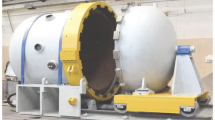Abstract
The possibility of realizing the solution of mankind's energy problem by the explosive thermonuclear fusion method that was proposed by Academician A. D. Sakharov is assessed. The essence of the method consists of the use of the energy of low–power thermonuclear explosions performed cyclically in stationary explosion–proof chambers equipped with a means for selection and utilization of the thermal energy of the explosion. Here the basic problem is to design airtight chambers capable of withstanding multiple thermonuclear explosions whose power is equal to ≈10—25 ktons of TNT. The available data on this problem are examined. The concept of designingreliable explosion–proof chambers for the solution of the indicated problem is formulated.
Similar content being viewed by others
REFERENCES
G. A. Ivanov, N. P. Voloshin, A. S. Ganeev, et al., Explosive Deuterium Energetics [in Russian], Inst. of Tech. Phys., Snezhinsk (1996).
S. V. Putvinskii, “Is the world power system without nuclear fusion possible?", Usp. Fiz. Nauk, 168, No. 11, 1235–1246 (1998).
A. D. Sakharov, “Nuclear power and freedom of the West,” Ekokhronika, No. 3 (1995).
“13Ya facility,” Advertisement, Inst. of Exp. Phys., Sarov (1993).
A. I. Abakumov, F. V. Grigor'ev, V. P. Solov'ev, et al., “Dynamics of deformation of spherical vessels under internal explosive loading,” in: Applied Problems of Strength and Plasticity. Algorithmization and Automation of the Solution of Scientific Studies (collected papers) [in Russian], Gor'kii Univ. Nizhnii Novgorod (1998), pp. 53–57.
E. F. Marwick, U.S. Patent No. 4121969, “Contained fissionly vaporized imploded fission explosive breeder reactor,” Published 10.24.78, Vol. 975, No. 4.
A. G. Ivanov, “Dynamic fracture and scale effects,” Prikl. Mekh. Tekh. Fiz., 35, No. 3, 116–131 (1994).
Wessel, Pryle, Clark, “Calculations of steel constructions with large cross section by methods of fracture mechanics,” in: Yu. N. Rabotnov (ed.), New Methods of Estimating the Resistance of Metals to Brittle Fracture (collected scientific papers) [Russian translation], Mir, Moscow (1972), pp. 213–244.
N. Nakayama, M. Ohashi, T. Sano, et al., “Dynamic stress concentration factor in the strip plate with fillet,” in: J. de Physique, IV (France), 7 (1997), pp. c3–295–c.3–300.
A. G. Ivanov, V. A. Sinitsyn, and S. A. Novikov, “Scale effects upon dynamic fracture of constructions,” Dokl. Akad. Nauk SSSR, 194, No. 2, 316–319 (1970).
A. G. Ivanov, S. A. Novikov, and V. A. Sinitsyn, “Scale effect upon explosive fracture of closed steel containers,” Fiz. Goreniya Vzryva, 8, No. 1, 124–129 (1972).
A. G. Ivanov, A. A. Uchaev, V. A. Ryzhanskii, et al., “Pulse fracture of geometrically similar objects,” Dokl. Akad. Nauk SSSR, 261, No. 4, 868–871 (1981).
A. G. Ivanov, V. A. Ryzhanskii, V. V. Zhukov, et al., “Experimental study of the effect of scale on the strength of a high-pressure boiler under internal explosive loading,” Fiz. Goreniya Vzryva, 17, No. 3, 102–108 (1981).
G. P. Cherepanov, Mechanics of Brittle Fracture [in Russian], Nauka, Moscow (1974).
G. M. Boyd, in: H. Liebowitz (ed.), Fracture, Vol. 5: Fracture Design of Structures, Academic Press, New York-London (1968).
A. G. Ivanov, “Brittle strength of thin-walled vessels,” Probl. Prochn., No. 6, 49–53 (1988).
A. G. Ivanov, “Integral approach to the problem of fracture,” in: High Energy Densities (collected scienti fic papers) [in Russian], Inst. of Exp. Phys., Sarov (1997).
V. A. Ryzhanskii, V. N. Mineev, A. G. Ivanov, et al., “Fracture of cylindrical glass-epoxide shells filled with water under internal pulse loading,” Mekh. Polimer., No. 2, 283–289 (1978).
A. G. Ivanov and V. I. Tsypkin, “Deformation and fracture of glass-reinforced plastic shells under extreme pulse loading,” Mekh. Kompoz. Mat., No. 3, 472–480 (1987).
A. G. Fedorenko, and M. A. Syrunin, and A. G. Ivanov, “Effect of the reinforcement structure of oriented glass-reinforced plastics on the strength of circular cylindrical shells under explosive loading from within,” Mekh. Kompoz. Mat., No. 4, 631–640 (1991).
A. G. Ivanov, “Transportable localizing container for explosive cargoes,” in: Symp. on Accident Resistant Containers and Transportation Safety, Albuquerque, NM, October 26-November 2, (1993).
A. G. Ivanov, A. G. Fedorenko, and M. A. Syrunin, “The possibility of increasing the safety of nuclear weapons,” Fiz. Goreniya Vzryva, 32, No. 2, 169–171 (1995).
A. G. Fedorenko, M. A. Syrunin, and A. G. Ivanov, “Dynamic strength of spherical glass-fiber shells under internal explosive loading,” Fiz. Goreniya Vzryva, 31, No. 4, 93–99 (1995).
V. V. Panasuyk, A. E. Andreikiv, and S. E. Kovchik, Methods of Estimating Crack Resistance of Structural Materials [in Russian], Naukova Dumka, Kiev (1977).
R. J. Weimer and H. C. Rogers, “Dynamic fracture phenomena in high-strength steels,” J. Appl. Phys., 50, No. 12, 8025–8030 (1979).
B. Gaily and J. Petit, “Inuence of the microstructure on armor steel spelling,” in: Shock Compression of Condensed Matter, Proc. of the Conf. of Amer. Phys. Soc. (Seattle, Washington, August 13–18, 1995), Part 1 (1995), pp. 635–638.
F. Whipple, Orbiting the Sun, Harvard Univ. Press, Camridge (1981).
G. Kolsky and D. Rader, “Stress waves and fracture,” in: H. Liebowitz (ed.), Fracture, Vol. 1: Microscopic and Macroscopic Fundamentals, Academic Press, New York-London (1968).
A. G. Fedorenko, V. I. Tsypkin, M. A. Syrunin, et al., “Behavior of composite shells with a high-elastic binder under internal pulse loading,” Mekh. Kompoz. Mat., No. 2, 306–314 (1988).
V. A. Ryzhanskii, A. G. Ivanov, V. V. Zhukov, et al., “Explosion safety of the cylindrical part of the vessel of a fast reactor,” Atom. Énerg., 79, No. 3, 178–188 (1995).
V. Z. Parton, Fracture Mechanics. From Theory to Practice [in Russian], Nauka, Moscow (1990).
Author information
Authors and Affiliations
Rights and permissions
About this article
Cite this article
Ivanov, A.G., Syrunin, M.A., Fedorenko, A.G. et al. The Concept of Chamber Design for Explosive Thermonuclear Fusion Energetics. Combustion, Explosion, and Shock Waves 36, 832–839 (2000). https://doi.org/10.1023/A:1002875327578
Issue Date:
DOI: https://doi.org/10.1023/A:1002875327578



